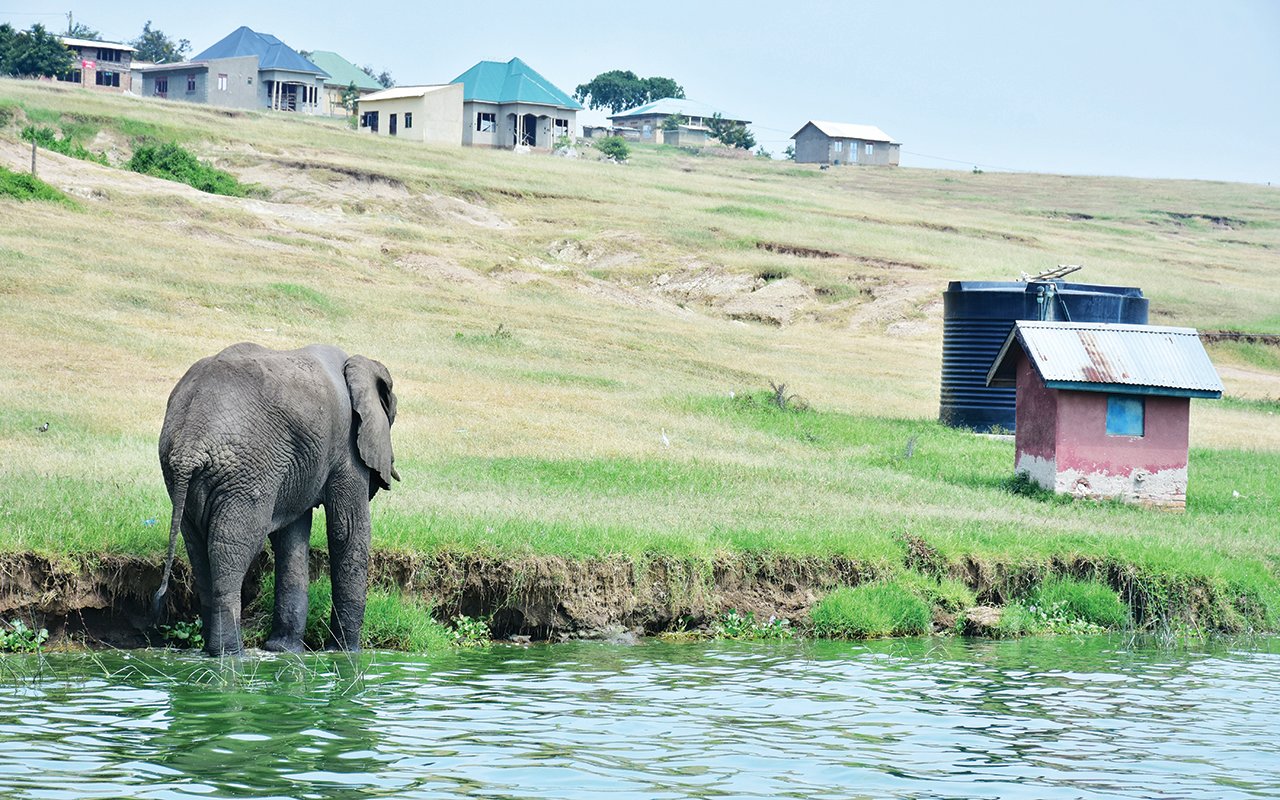
A section of Ternan Avenue in Kampala had several trees cut down in October 2024.
On October 14, Kampala Capital City Authority (KCCA) shamelessly ordered the cutting of trees in the city centre occupied by breeding and roosting colony of the Cattle Egrets. Why? Some say it is to aid signalisation of the roads.
The cattle keepers in Uganda would understand the critical symbiotic importance of cattle egrets with cows. Indeed, the egrets only use Kampala trees for roosting and more recently for breeding because they seek safely in town but mainly feed outside the city. Egrets in Kampala are ‘refugees’ and you can see them flocking into the town in the evening and out in the morning. Uganda is well known as a hospitable country and hosts over 1.5 million human refugees but KCCA cannot host a few hundred cattle egrets for just a night. Shame.
In 1986, Dr Margaret Casswell, a renowned Ornithologist documented nearly 600 bird species in Kampala City and its environs. Our recent records indicate that Kampala City alone boasts of nearly 300 species of birds. This species diversity is probably the highest of any other city in the world. A morning bird walk in any suburbs of the city would reveal more than 80 species. Our recent survey of Lubigi Wetland alone recorded 100 species. Visitors of Kampala City are always fascinated by this diversity, in particular the marabou stork, the biggest stork in the world with the largest wingspread of any living bird.
This massive stork, commonly known as Karoli, lives side by side with people, feeding along busy streets, successfully nesting and fledging young in the city centre. Some visitors call the marabou the unofficial national bird of Uganda because of the welcome it provides to the people, right from the airport to the middle of the City. Kampala City has the biggest breeding population of marabous in the world. However, visitors would be deceived to think, though, the Kampala City authorities are protective of these birds and probably other animals. The calm, gentle, rarely aggressive bird fights for its survival every day from the threat of poisoning and destruction of its breeding sites by the City authority.
Historically, tourism in Uganda was based on mammals, the big five. Prior to 1990s, almost no birding tourism was existent, but since the 1990s many organisations, non-governmental organisation (NGOs), birding groups and guides have relentless promoted birding tourism in Uganda as a hidden and unexplored tourism product. Nature Uganda in particular has ensured that information is available through biological assessments, annual surveys, monitoring and availed this information through reports and publications, public talks, organising national birding days, identifying important bird areas, and many other activities.
To date, birding or tourism based on birds is the second biggest tourism product for Uganda. Uganda boasts of more than 1,070 species of birds, nearly 50 percent of all African species and close to 10 percent of the global species. Estimates based on birding visitors indicate that a birder spends not less than $4,000 in the countries they visit. Uganda receives more than 20,000 birders annually and this translates to more than $ 80,000,000 coming into our economy because of birds. When Whiston Churchill described Uganda as the Pearl of Africa, he did not mean minerals, oil or agriculture, the Pearl referred to the streaming and abundant biodiversity in all landscapes he went that captivated the visitor. Its nearly 115 years since he visited Uganda, KCCA is yet to appreciate the pearl in the city.
Previously, I have written about marabou storks in Kampala. Marabou storks are scavengers, which means, they consume or feed on decaying materials. For Marabou storks, they feed on meat, and other food materials. Naturally marabous are not supposed to live in towns but rather near wetlands, lake shores and fish landing sites. However, marabous found refuge in Kampala because of food availability and good nesting sites. Records show that the population of marabous has been increasing since 1969 when the first count of the breeding population was made. In Kampala, the breeding population has increased from 11 pairs in 1969 to more than 1,500 breeding pairs in 2022. The non-breeding population is estimated to be more than 10,000. The numbers of the breeding pairs and nonbreeding individuals will continue to increase as long as food availability remains abundant in the City even if all trees are cut down. We have already recorded marabou nesting on large billboards. The grey-crowned crane, our national bird and the only tree roosting Crane on the world, now uses electricity pylons leading to electrocution of some individuals because appropriate trees have been cut down.
Therefore, the recent invasion of cattle egrets in the city is closely associated with the presence of marabou storks. The cattle egrets will always breed in colonies (large flocks) or breed in or near trees where other big birds are present or are breeding. Both strategies are for security or safety from prey. The bigger birds provide pseudo protection. It is no surprise therefore that cattle egrets are breeding or occupying same areas where marabous are breeding such as Makerere, Nakasero, Rubaga, Namirembe, Mulago and other places.
These places have equally become major roosting sites of the egrets. In addition, marabous have a gregarious behaviour in nesting, an advantage because pairs that have bred successfully return to the same site/colony, the young inexperienced breeders seeking sites join an already established colony as the latter’s existence is an indication that the site/colony is safe in food supply, protection from predation, harassment and interference.
The young pairs are also poor in finding food for the chicks, thus would be directed to foraging areas by the experienced breeders. Therefore, even if all trees in Kampala are cut down and the food remains available, these creatures will substitute the nesting sites from trees to buildings, probably in the same areas where they nest today such as parliament buildings, KCCA buildings, High court buildings, Makerere University, State house area and other preferred areas for nesting. In Europe, White Storks have already substituted their nesting sites from trees to buildings only that in this part of the world, the birds are not persecuted.
The marabous are an extremely useful animal in the city, it is one bird that should be protected and revered by KCCA. This is why. The food for marabou is carrion, dead dogs, cats and other dead animals that are not collected or otherwise difficult to find. In the city with mushrooming and scattered abattoirs, roaming animals knocked by cars every day the Marabou is the cleaning companion where KCCA is not available or unable to reach. One marabou eats one to two kilos of food daily. With more than 10,000 individuals in the city, these wonderful birds consume between 10,000kgs and 20,000kgs of food daily. Reports indicate that KCCA is unable to collect 40 percent of waste in the city and marabou storks diligently collect between 10 and 20 tonnes of this waste daily, helping to maintain the health and balance of the ecosystem and reducing incidences of disease.
Missing link
So why would KCCA persecute these species coming into the city. If KCCA cleaned the City, there is no doubt the marabous and cattle egrets and many other scavengers feeding on waste would find their way out of the City, probably to where they naturally occur. Marabous have a breeding season regime of about 190 days from August to January or February, approximately 6½ months from the time of nesting to when the young become independent (fledge). Similarly, cattle egrets breed from April to October. Whereas there may be some seasonal variations, the period for breeding of both species is well known. Why would KCCA decide to cut or trim trees in the middle of the breeding season for the species? Why not schedule such activities in the non-breeding season or months.
Already there is a discussion going to transform Lubigi wetland into an Eco Park (Ecological Park), an area reserved for conservation and ecotourism. This is a fantastic idea that implements sustainable development goal (SDG) No.11 on sustainable cities and communities. NatureUganda, conservation organisation in Uganda, has completed a biodiversity assessment of the wetland and the records indicate globally threatened species such as the grey-crowned cranes, hooded vultures, papyrus endemic species such as gonoleks are present. In more wooded areas of the city such as Kololo, golf valley there are surprisingly forest species such a great blue turacos, ross’s turacos, grey parrots, brown parrots, palmnut vultures, woodpeckers, starlings, etc. In fact, KCCA can market Kampala City and its environs as a unique birding destination with well-designed itineraries, indeed a perfect place to develop and promote domestic tourism. In view of this, KCCA ought to protect all green spaces rather than aiming at creating a forest of concrete, devoid of trees and biodiversity. The technical department on environment and tourism must provide information to guide these activities.
In order to promote a sustainable City, KCCA must protect all green spaces, plant more trees, especially the indigenous plants that support biodiversity conservation. If KCCA provided only five seedlings to homes with space, more than one million trees can be raised in less than five year in the city. That would create more space for egrets and marabous, alternative roosting sites and a better greener city in the future. The technical organisations including National Environment Management Authority, Uganda Wildlife Authority, National Forestry Authority, and specialised NGOs such as NatureUganda would be available to provide technical support.
Waste issue
Reports indicate that KCCA is unable to collect 40 percent of waste in the city and marabou storks diligently collect between 10 and 20 tonnes of this waste daily, helping to maintain the health and balance of the ecosystem and reducing incidences of disease
The writer, Achilles Byaruhanga, is the Executive Director of NatureUganda, a conservation organisation




